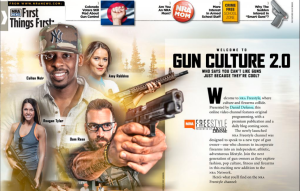The concept of a “gun culture” is an interesting notion. The phrase is frequently used, most often negatively by anti-gun activists but it’s also been adopted as a positive description of values by many gun owners. What is it, and what does “culture” have to do with guns?
First of all, there is certainly not a monolithic “gun culture”, because people appreciate firearms from a number of perspectives. We may be interested in different kinds of sport; that may be some form of target shooting, recreationally or competitively. We may care more about hunting, which is another personal challenge and a physically healthy pursuit that can also feed us. We may admire their fine craftsmanship, be fascinated by the history of firearms and collect them.
It may be important to us to be able to protect ourselves and loved ones against assailants who can be bigger, stronger, and more brutal and opportunistic than us. I doubt that many of us see ourselves as public menaces. Most of us are quite sincere about handling such dangerous implements carefully and using them safely. But that’s just our view.
On the other hand, candidate Obama famously called out a “gun culture” in which gun owners bitterly “cling to guns or religion” as well as being xenophobic and protectionist due to economic hardship. There are many similar stereotypical anti-gun beliefs, held emotionally or with supposed objectivity.
A recent example is “Gun Owners and Social Gun Culture”, a study based on data from YouGov.com (an organization that polls self-selected panels) and policy information from the Brady Law Center and Injury Prevention and Control Center. (The full Injury Prevention journal report can be obtained via the British Medical Journal’s pay site.)
Dr. Bindu Kalesan et al discovered that among the one-third of respondents identifying themselves as gun owners, 2-2.5 times as many join in gun-related social activities as don’t. Their declared agenda is to reduce gun ownership for “public health” reasons, which means that favorable attitudes about guns need to be changed. So that may require challenging the reinforcement for gun ownership that such social activities provide.
The authors also determined that the typical American gun owner is a high income white male over 55 years old—a profile that is unrepresentative of the increasing diversity of people who enjoy shooting. But depicting older, well-off white guys perpetuates a popular negative image for many purposes.
Their work is fundamentally flawed, given their basic premise that injury prevention requires altering the American public’s increasingly positive attitude toward gun ownership. But how these authors and the Brady Center see “gun culture” is an example of how we can be seen in the world at large.
It’s revealing that they assume there’s something wrong with gun owners associating socially and sharing gun-related activities. It’s hard to imagine the same point of view about American car culture. That similarly involves appreciation of the workmanship, aesthetics, and variety of uses of vehicles that are proportionally responsible for far more injuries and deaths than firearms.
This “anti-gun culture” would be a joke, if they weren’t so convinced. If you’ve ever “attended gun safety classes” or “advocated responsible gun ownership” (responses that indicated to the authors participation in the dangerous “gun culture”) you have been with people whose emphasis on safety and accountability is probably unequaled among amateur sportsmen. Larry Keane, senior vice-president of the National Shooting Sports Foundation, points out that Kalesan et al should say “Thank you, U.S. Gun Culture” for, yes, cultivating citizens “who are willing to take on the responsibility that comes with owning a firearm”.
A curious angle involves anti-gun allegations that gun owners are paranoid about the world, or are afflicted with subconscious or sexual inadequacies. As a psychiatrist, I suspect this is projection. As a physician and a human being with experience of illness, injury, death and violence, I am more inclined to empathy for the targets of such claims than for the accusers.
I like Andrew Scott’s take on this in “The Staggering Safety of Living with Concealed Carry Holders Among Us”. He very fairly calculates the odds of the average American getting killed by someone random as about 285 times greater than by a concealed carry holder.
Concealed carriers aren’t an exact proxy for all the 30-50% of Americans who own guns, but this is hard data that should be representative given that exponential difference in risk. There are plenty of everyday risk comparisons that favor firearms. Scott points out, for example, that we are about 7 times more likely to get struck by lightning and twice as likely to win the Powerball jackpot as to die at the hands of a licensed handgun user. Now who’s paranoid?
The word “culture” itself comes from the millennia old concept of “cultivation”, helping to grow things and, likewise, human accomplishment. Per the Oxford English Dictionary, “culture” denotes collective human intellectual achievement and our “refined” understanding and appreciation of it, particularly the customs, arts, social institutions, attitudes and behaviors characteristic of a particular social group.
“Gun culture”—sounds pretty special, doesn’t it?

— DRGO editor Robert B. Young, MD is a psychiatrist practicing in Pittsford, NY, an associate clinical professor at the University of Rochester School of Medicine, and a Distinguished Life Fellow of the American Psychiatric Association.

